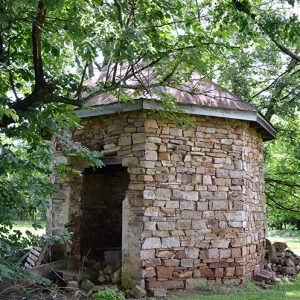calsfoundation@cals.org
Morrison Plantation Smokehouse
The Morrison Plantation Smokehouse, the last remnant of the Morrison Plantation, is a stone structure that was constructed around 1854 near the communities of Saginaw and Midway in Hot Spring County. It was added to the National Register of Historic Places on December 28, 1977.
Daniel Morrison moved to Hot Spring County around 1838 and began purchasing land along the Ouachita River near the future settlement of Midway. Born around 1810 in Georgia, he owned thousands of acres by 1850, including an island in the Ouachita River called Watermelon (or Water Mellon) Island. In addition to several hundred acres located on both sides of the Ouachita in Hot Spring County, Morrison also owned more than a thousand acres in nearby Clark and Dallas counties. Morrison owned numerous enslaved workers and used their labor not only to work his land but also to construct several buildings. These included a Greek Revival–style home and slave cabins. The slaves also constructed a stone smokehouse that was used to preserve and store meat.
The smokehouse is located west of the Ouachita River and is constructed in a hexagon shape from randomly laid fieldstones. The structure is topped with an eight-paneled metal roof that contains two gablets to allow smoke to escape. When originally constructed, circa 1854, a wood roof topped the building. A single door leads into the structure from the west. The door is only five feet ten inches in height but is four feet six inches wide. The interior originally had a packed earth floor that was later covered with concrete.
The smokehouse was only one part of an extensive agricultural enterprise. Morrison planted corn and cotton on the plantation but also had extensive orchards of apple and pear trees. Patches of wild watermelons also grew on the island, which gave it its name. He regularly visited Camden (Ouachita County) to obtain supplies for his operation and decorated his home with furniture shipped from New Orleans, Louisiana.
In 1860, Morrison owned twenty-four slaves who worked his extensive hand holdings in Hot Spring County. During the Civil War, Morrison fled to Texas with his slaves. At the conclusion of the war, he returned to his plantation with some of his now freed slaves and continued farming a number of crops.
Daniel Morrison and his wife, Belle Morrison, had one son and three daughters. He died in 1888 and is buried with his wife in the Midway Cemetery.
The smokehouse is the last remaining structure in the twenty-first century that was part of the Morrison Plantation. It is located on private property.
For additional information:
Hodges, T. L. “Watermelon Island.” The Heritage 8 (1981): 41–49.
“Morrison Plantation Smokehouse,” National Register of Historic Places nomination form. On file at Arkansas Historic Preservation Program, Little Rock, Arkansas. Online at http://www.arkansaspreservation.com/National-Register-Listings/PDF/HS0047.nr.pdf (accessed September 17, 2019).
David Sesser
Henderson State University
 Historic Preservation
Historic Preservation Louisiana Purchase through Early Statehood, 1803 through 1860
Louisiana Purchase through Early Statehood, 1803 through 1860 Morrison Plantation Smokehouse
Morrison Plantation Smokehouse 




Comments
No comments on this entry yet.